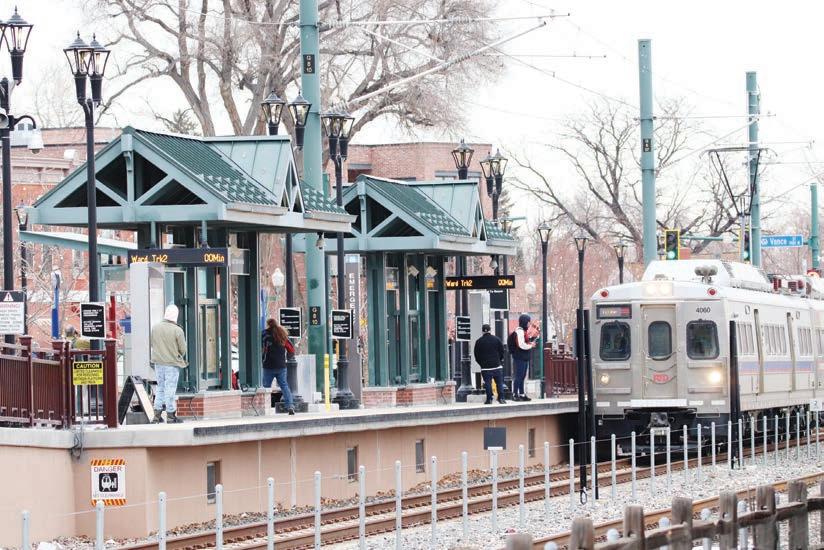
5 minute read
STRESSES
that government must provide the needed funding to bolster the supply side of the housing market.
“We do things (on) the supply side, but it’s not enough,” Throupe school as well,” Baca-Oehlert said. e 2022 Healthy Kids Colorado Survey also told a dismal story for LGBTQ+ children: around 20% of gay, bisexual and lesbian youth reportedly attempted suicide in the last year. e number was higher for transgender students at 26%.

“I think it also sends a message to the students in that building that if the educator isn’t accepted, what does that mean for me, as a student,” said Kasey Ellis, counselor and president of the Cherry Creek Education Association.
As American public spaces are plagued by gun violence, 67% of the residents, both in its history and future. e area is also home to a bighorn said. “And you can’t expect a developer to build something and lose money.” respondents reported feeling “very” or “somewhat” worried about a mass shooting at their school. While some politicians have proposed increasing school security and arming teachers with guns, most respondents said carrying guns would make them feel even less safe. What would help increase feelings of security, 39% of respondents said, is increased access to mental health resources.
“Silver mining is what built the town of Silver Plume,” said Silver Plume Mayor Sam McCloskey.
McCloskey has a personal connection to the area as well.
“It’s near and dear to me because I had several of my ancestors who worked these mines,” he said.
McCloskey likened the land purchase to a 200-acre museum, due to all the historical signi cance the area holds.
Spending from higher levels of government could benefit in particular the suburbs, which are struggling with housing affordability but have less political appetite to tackle the problem themselves, Freemark said.
While the state legislature convenes over the next several months, education association members said they hope legislators prioritize a ordable housing, higher teacher’s salaries, sheep herd, which the land purchase will protect by designating the area as open space.
Cynthia Neely was the project manager helping to facilitate the land purchase. She explained the area is part of the Georgetown-Silver Plume National Landmark District, which has the purpose of preserving the history of silver mining in the area.
“For 30 years, one of the goals of the historic agencies in the district has been to secure the mountainsides in the districts,” Neely said.
Not only does this 200-acre land
“Ultimately, the most exclusionary places, which are often suburbs, have no incentive to invest in affordable housing” because “they don’t see affordable housing as (needed) by their residents,” Freemark said.
That said, creating housing affordability for key workers like teachers, police and firefighters is an important part of the puzzle for communities, Throupe said.
“You lose your teachers, and then you lose the quality of your schools, and it hurts the area. Same with police and fire,” Throupe said.
In the larger business community, housing plays a crucial role too, Polis said.
“Coloradans have to be able to afford to live in our communities where they can earn a good living, and companies need to be able to find the workers they need to thrive,” he said in the speech.
‘We are not California’
The governor’s one-liner when speaking about housing — “We are not California. We are Colorado” — raises the question of where the state could be headed if it doesn’t change course.
Net migration, the difference between the number of people coming into and the number of people leaving an area, has long been positive in Colorado. In 2015, net migration was about 69,000 people, according to the State Demography Office. Although the number reached a recent pre-pandemic low in 2019 with about 34,000, education licensing, educator working conditions and mental health for both students and teachers. is story is from Rocky Mountain PBS, a nonpro t public broadcaster providing community stories across Colorado over the air and online. Used by permission. For more, and to support Rocky Mountain PBS, visit rmpbs. org. purchase include the iconic Mendota Mine, but the sites of an estimated 20 mines that saw active operation in the 19th century, according to Neely. Neely hoped that beyond the preservation of the cultural remnants of the mines and the protection of nature, the area could become a space for people to learn about the rich history of Silver Plume. newcomers are still flowing in.

“ ough Coloradans often pride themselves on being progressive and championing inclusion, our state’s budget on education tells a di erent story,” Baca-Oehlert concluded.
“We want to share a story,” she said.
Now, the town waits for the completion of the conservation easement of the area, which will likely take a few more months due to weather.
“There are (home) buyers moving in from out of state, and many of them come from higher-priced areas, so they don’t have sticker shocks,” Throupe said, speaking to the sustained high demand and high prices in metro Denver.
Looking to the future, Throupe doesn’t think the metro Denver housing market is on a similar trajectory that large metro areas such as New York City and San Francisco have experienced in terms of high housing prices.
“New York is a coastal city and a financial center — same with (several) California (cities), San Francisco. We’ll never be that. We’re our own animal,” Throupe said.
“The choice between those cities and Denver pricing-wise has been extreme; it’ll tighten up. It’ll never be their prices, but it’ll tighten up,” Throupe added.
Freemark noted that geographically, Denver has less of a physical barrier to new construction than in places like San Francisco — and that New York City is largely surrounded by water.
Rogers, the teaching assistant professor in the program for environmental design at CU Boulder, described the metro Denver housing market’s future in terms of uncertainty.
“I think that we are in a place we’ve never been before, so I can’t extrapolate the future from that,” Rogers said. “I feel like we’re in unknown waters.” restaurants are within walking distance” went from 47% in 2019 to 39% in 2021. e Pew Research Center said the shift occurred during the COVID-19 pandemic with increased “telework, remote schooling and pandemicrelated restrictions on indoor dining and other indoor activities.”


Despite attitudes shifting against density, Riger said the region mostly will densify with many municipalities at build-out and reaching their outward boundaries as population increases.
“I think it’s going to be a mix of growing out and growing up,” he said.

With higher density comes transit options, because land use is a transportation strategy.
According to the Colorado Department of Public Health, transportation was the second largest greenhouse gas contributor for the state by sector, losing to electric power as the rst.
With mixed-use, well designed, higher density areas, residents are able to walk more, reduce their travel times and distances, and have the ability to support transit lines and bike lanes.
An example could be seen in Olde Town Arvada.
Housing on transit lines

Since Cook moved into Arvada back in 1983, she’s seen the city transform into something di erent, crediting transit oriented development with bringing life into Arvada’s Olde Town. e city prevailed and the new transit oriented development transformed Arvada, Cook said. It created a center that attracts citizens from around the area and which bene ts merchants, restaurants and others.






Cook, along with several others, teamed up with Forward Arvada, a nonpro t looking to revitalize Olde Town in the 90s. ey tasked themselves with making an idea — to run a train line along decommissioned railroad tracks — into a reality to make sure Olde Town began to thrive.
Eventually, the G Line opened in 2019 and development began to spring up.
It didn’t happen without opposition, though. Residents voiced concerns over sacri cing the historical character of the town. In fact, the city faced lawsuits from a group called All the People regarding approving development plans to add to the transit oriented development, or TOD.
All of that can also be attributed to the mixed-use, higher density design model, where someone can live above a bakery or right next to a co ee shop.
With less emphasis put on cars, which Cook sees as a good thing, residents can live in a place where they can walk to various places. She said it contributes to more of a family feel.
See more on urban sprawl online at coloradocommunitymedia.com/ longwayhome/index.html.







